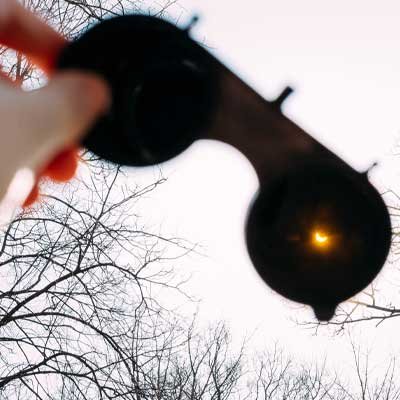Stay safe during the solar eclipse
 On Monday, April 8, more than 30 million people in the U.S. will experience a total solar eclipse as the moon’s shadow travels in an arc from Texas to Maine.
On Monday, April 8, more than 30 million people in the U.S. will experience a total solar eclipse as the moon’s shadow travels in an arc from Texas to Maine.
Whether in the path of totality or in a place where the eclipse will only partially cover the sun, celebrate this once-in-a-lifetime cosmic coincidence safely to prevent serious eye injury or even blindness.
Staring at the sun at any time, including during a solar eclipse, without protection is dangerous for your eyes, according to the American Academy of Ophthalmology.
Looking at the sun without the right eye protection — for even a short time — can damage your retina permanently. It can even cause blindness, called solar retinopathy.
Keep in mind that ordinary sunglasses, even very dark ones, or homemade filters are not safe for looking at the sun.
There is only one safe way to look directly at the sun, whether during an eclipse or not: through special-purpose solar filters. These filters are used in “eclipse glasses” or handheld solar viewers. They must meet a specific worldwide standard known as ISO 12312-2.
Carefully look at solar filter or eclipse glasses before using them. If there are any scratches or damage, do not use them.
- Always read and follow all directions that come with the solar filter or eclipse glasses. Help children to be sure they use handheld solar viewers and eclipse glasses correctly.
- Before looking up at the bright sun, stand still and cover your eyes with your eclipse glasses or solar viewer. After glancing at the sun, turn away and remove your filter — do not remove it while looking at the sun.
- The only time it is safe to look at the sun without a solar viewer is during a total eclipse. When the moon completely covers the sun’s bright face and it suddenly gets dark, it is OK to remove the solar filter to watch this unique experience. Then, as soon as the bright sun begins to reappear very slightly, immediately use your solar viewer again to watch the remaining partial phase of the eclipse.
- Please know Houston is NOT in the path of totality. To see which areas are, visit NASA’s website.
- Never look at the uneclipsed or partially eclipsed sun through an unfiltered camera, telescope, binoculars or other similar devices. This is important even when wearing eclipse glasses or holding a solar viewer at the same time. The intense solar rays coming through these devices will damage the protective filter in solar glasses and put eyes at risk.
- Talk with an expert astronomer on tips to using special solar filters with a camera, a telescope, binoculars or any other optical device.
Solar Eclipse Process
Partial solar eclipse
- First, there is a partial eclipse as the moon gradually covers the sun’s bright face.
- In most places, this process will take about one hour.
- Special eye protection (sunglasses are NOT enough) must be worn to directly observe the sun, during a partial eclipse or any other time.
Full solar eclipse (totality)
- The full eclipse, known as totality, happens when the moon completely covers the sun.
- This only lasts one to two minutes, but it is an incredible experience. The light of day gives way to a deep twilight sky. The sun’s outer atmosphere (called the solar corona) gradually appears, glowing like a halo around the moon in front of it. Bright stars and planets become more visible in the sky.
- During — and only during — this brief period, you may remove your eye protection. Put eye protection back on before totality ends.
Partial eclipse
- The eclipse then becomes partial again for an hour as the moon moves away.
- You must wear eye protection to look at the sun during a partial eclipse or any other time.